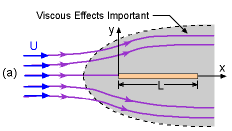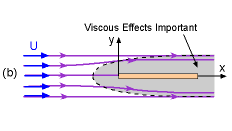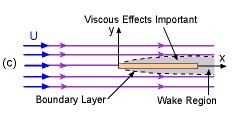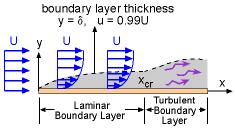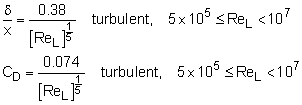| Ch 9. External Flow | Multimedia Engineering Fluids | ||||||
| Drag | Lift |
Boundary Layer |
|||||
| Boundary Layer Characteristics | Case Intro | Theory | Case Solution |
| Chapter |
| 1. Basics |
| 2. Fluid Statics |
| 3. Kinematics |
| 4. Laws (Integral) |
| 5. Laws (Diff.) |
| 6. Modeling/Similitude |
| 7. Inviscid |
| 8. Viscous |
| 9. External Flow |
| 10. Open-Channel |
| Appendix |
| Basic Math |
| Units |
| Basic Fluid Eqs |
| Water/Air Tables |
| Sections |
| eBooks |
| Dynamics |
| Fluids |
| Math |
| Mechanics |
| Statics |
| Thermodynamics |
| ©Kurt Gramoll |
|
|
|||||
|
The boundary layer theory will be introduced in this section through a discussion of the characteristics of flow past a flat plate. |
|||||
| Boundary Layer Theory - Flow Past a Flat
Plate |
|||||
|
|
When fluid flows past an immersed body, a thin boundary layer will be developed near the solid body due to the no-slip condition (i.e., fluid is stuck to the solid boundary). The flow can be treated as inviscid flow outside of this boundary layer, while viscous effects are important inside of this boundary layer. Take flow past a flat plate for example. The characteristics of flow past a flat plate with finite length L subject to different Reynolds numbers (Re = ρUL/μ) are shown in the figures. At a low Reynolds number (Re = 0.1), the presence of the flat plate is felt in a relatively large area where the viscous effects are important . At a moderate Reynolds number (Re = 10), the viscous layer region becomes smaller. Viscous effects are only important inside of this region, and streamlines are deflected as fluid enters it. As the Reynolds number is increased further (Re = 107),
only a thin boundary layer develops near the flat plate, and the fluid
forms a narrow wake region behind the flat plate. Hence, the flow can
be considered as inviscid flow everywhere except the boundary
layer region. The concept of a boundary layer was introduced and formulated by Prandtl for steady, two-dimensional laminar flow past a flat plate using the Navier-Stokes equations. Prandtl's student, Blasius, was able to solve these equations analytically for large Reynolds number flows. The details of the derivation are omitted for simplicity, and the results are summarized here. Based on Blasius' analytical solutions, the boundary layer thickness
(δ) for the laminar region is given by where δ is defined as the boundary layer thickness in which the velocity is 99% of the free stream velocity (i.e., y = δ, u = 0.99U). The wall shear stress is determined by If this shear stress is integrated over the surface of the plate ares, the drag coefficient for laminar flow can be obtained for the flat plate with finite length as If the flow is turbulent, then the equations for boundary layer and drag coefficient is |
||||
Practice Homework and Test problems now available in the 'Eng Fluids' mobile app
Includes over 250 free problems with complete detailed solutions.
Available at the Google Play Store and Apple App Store.
